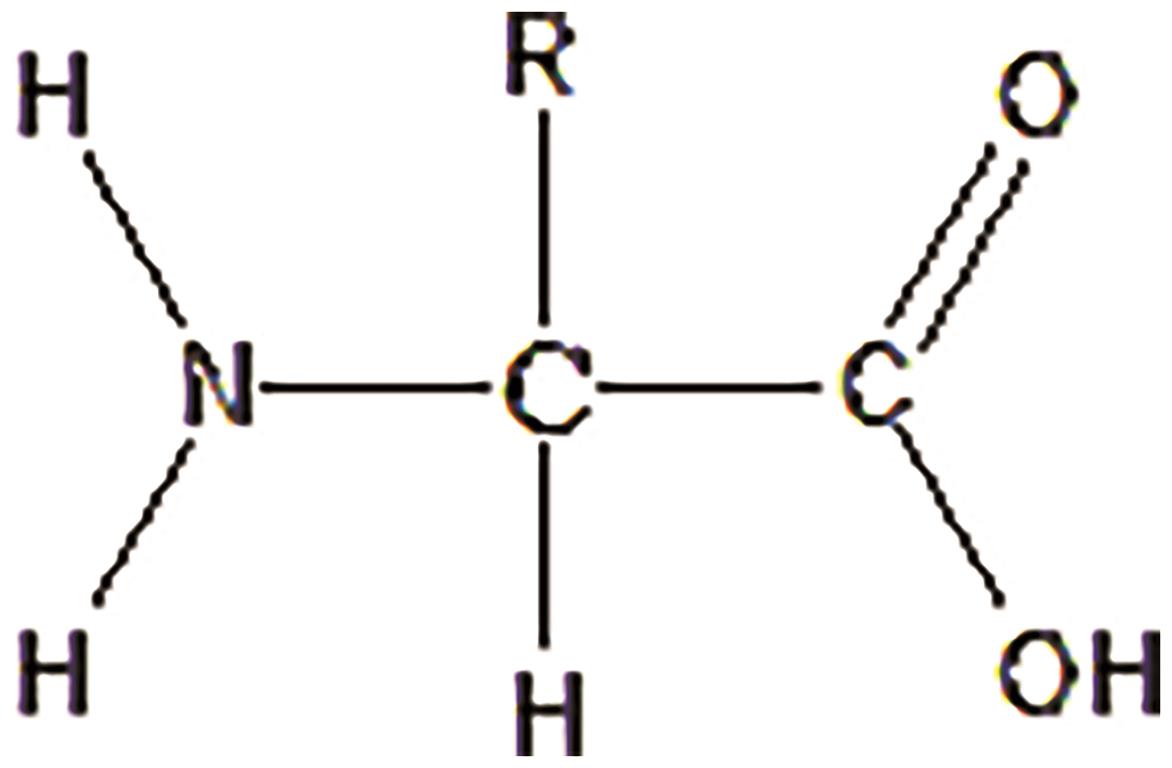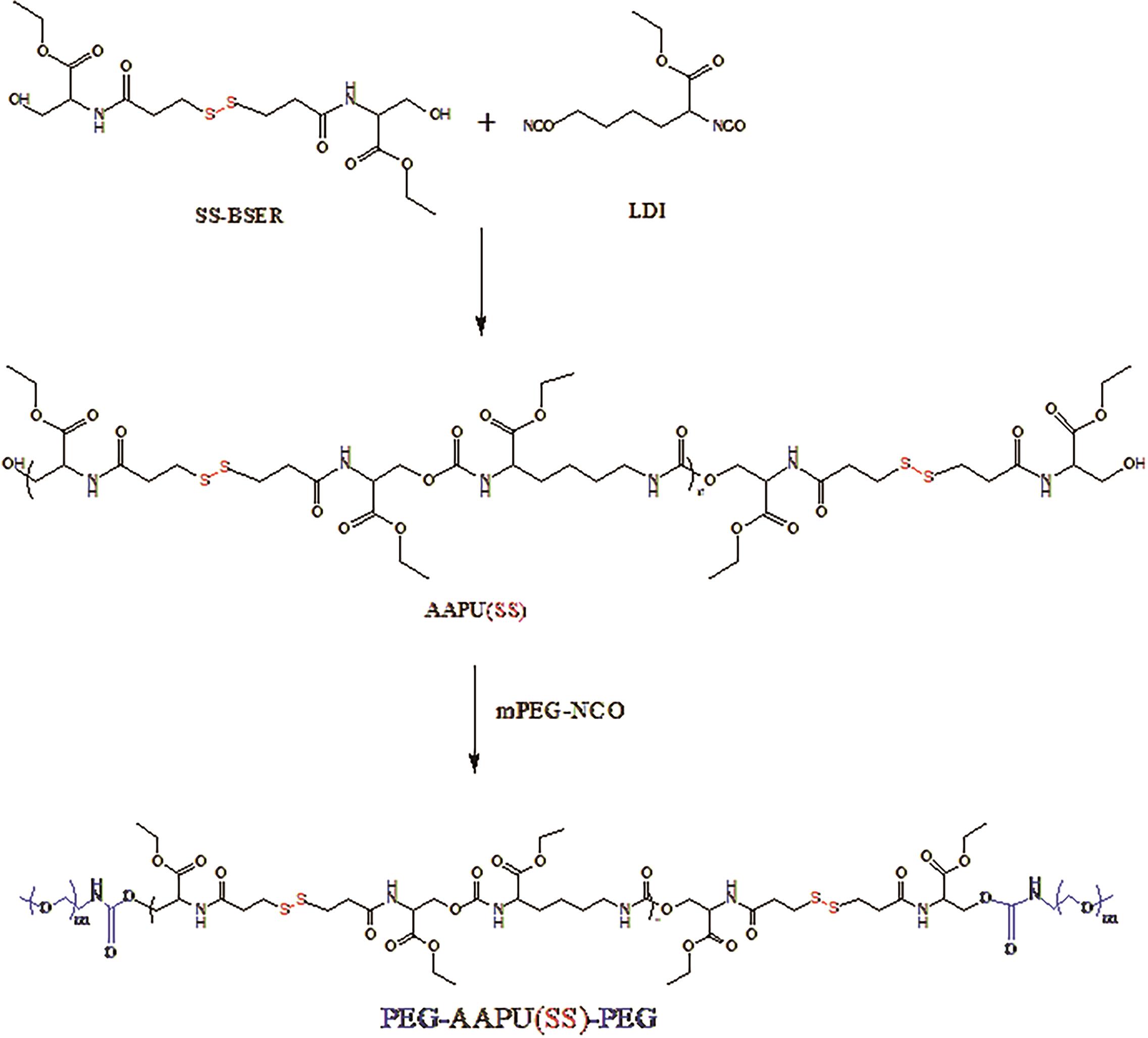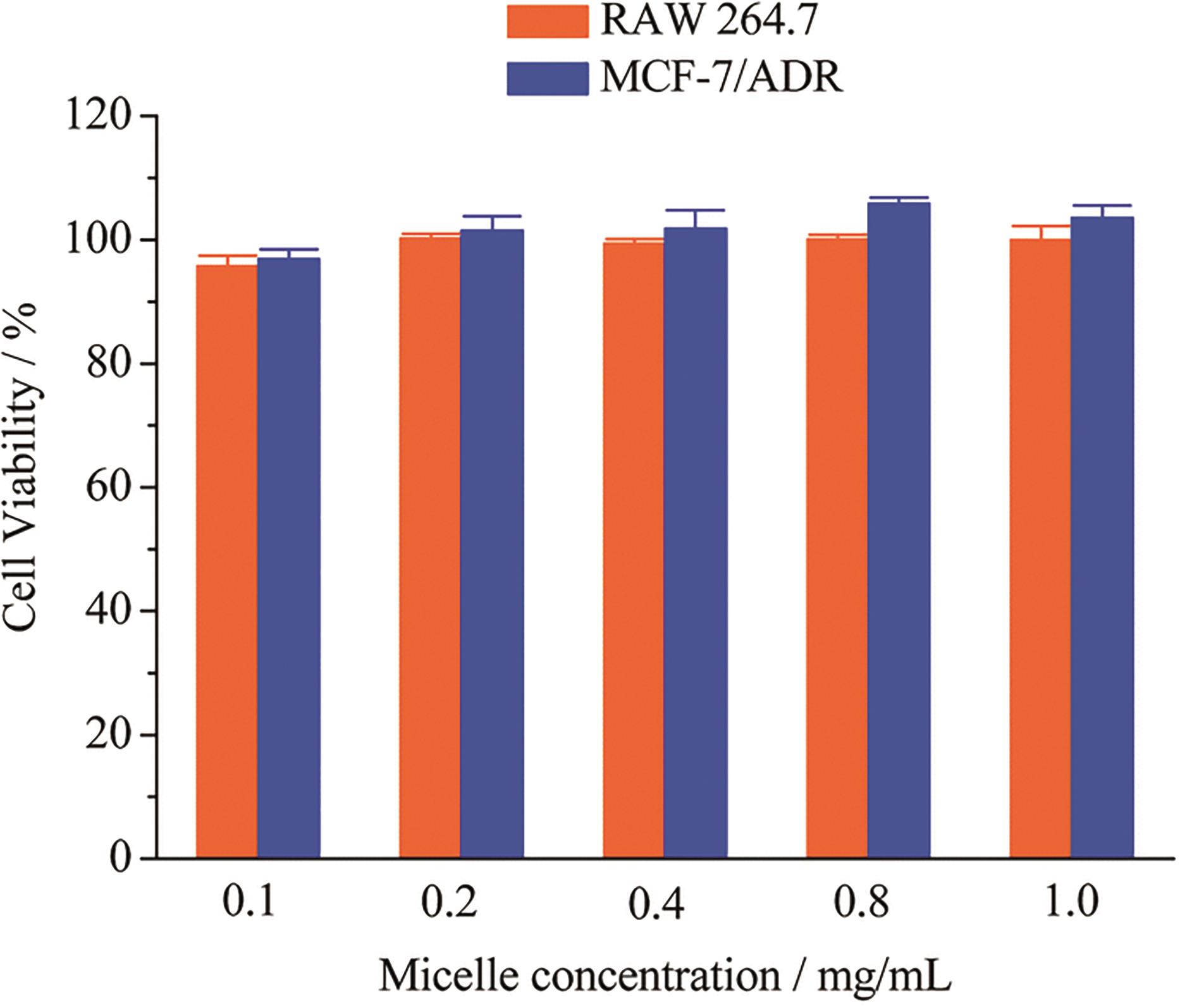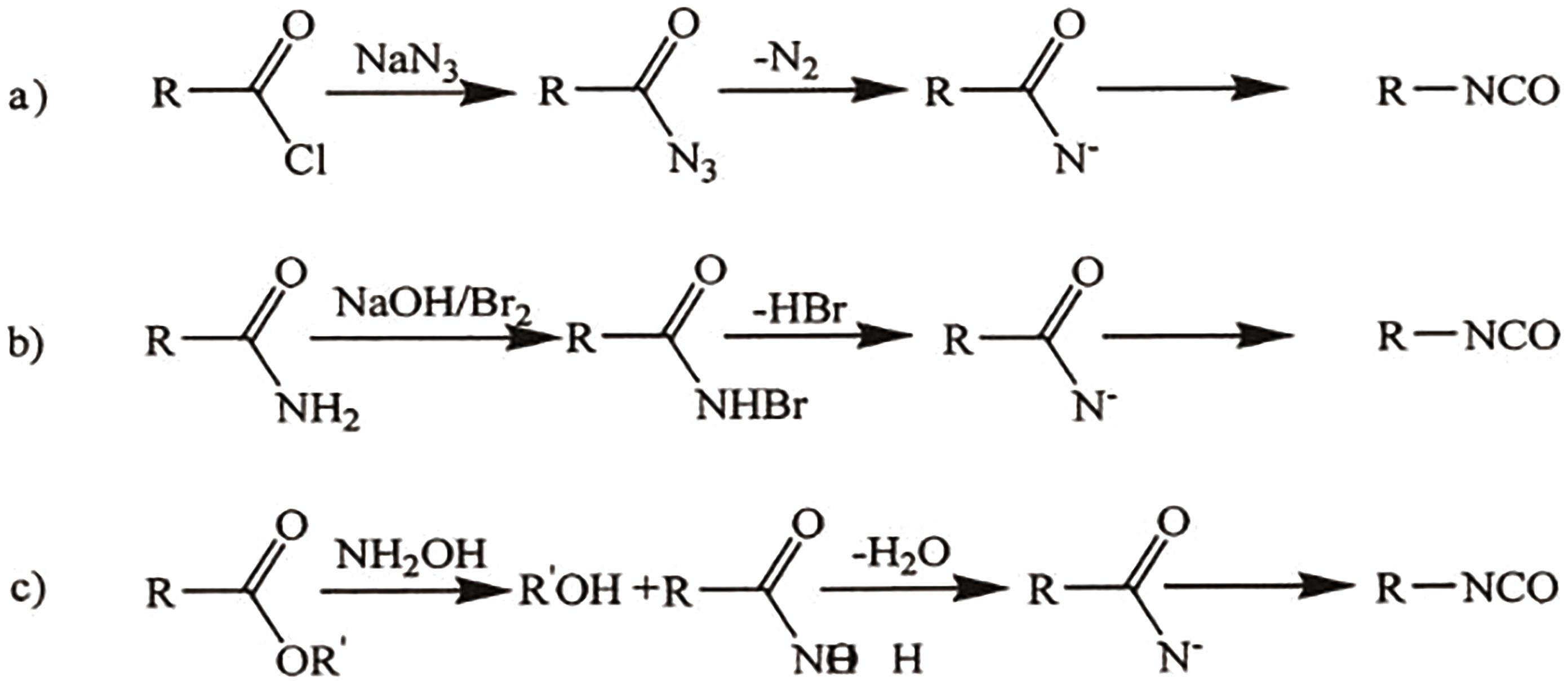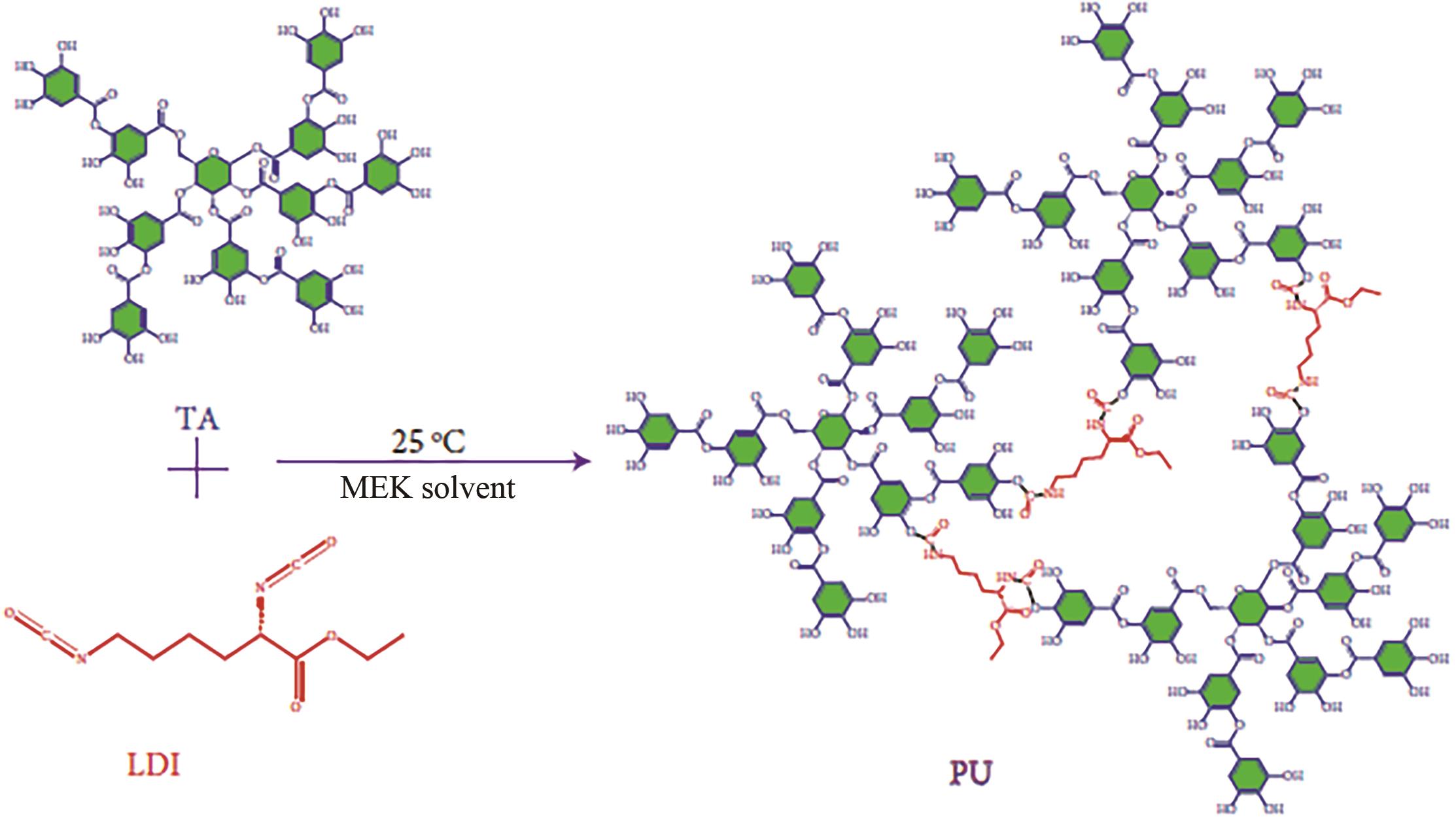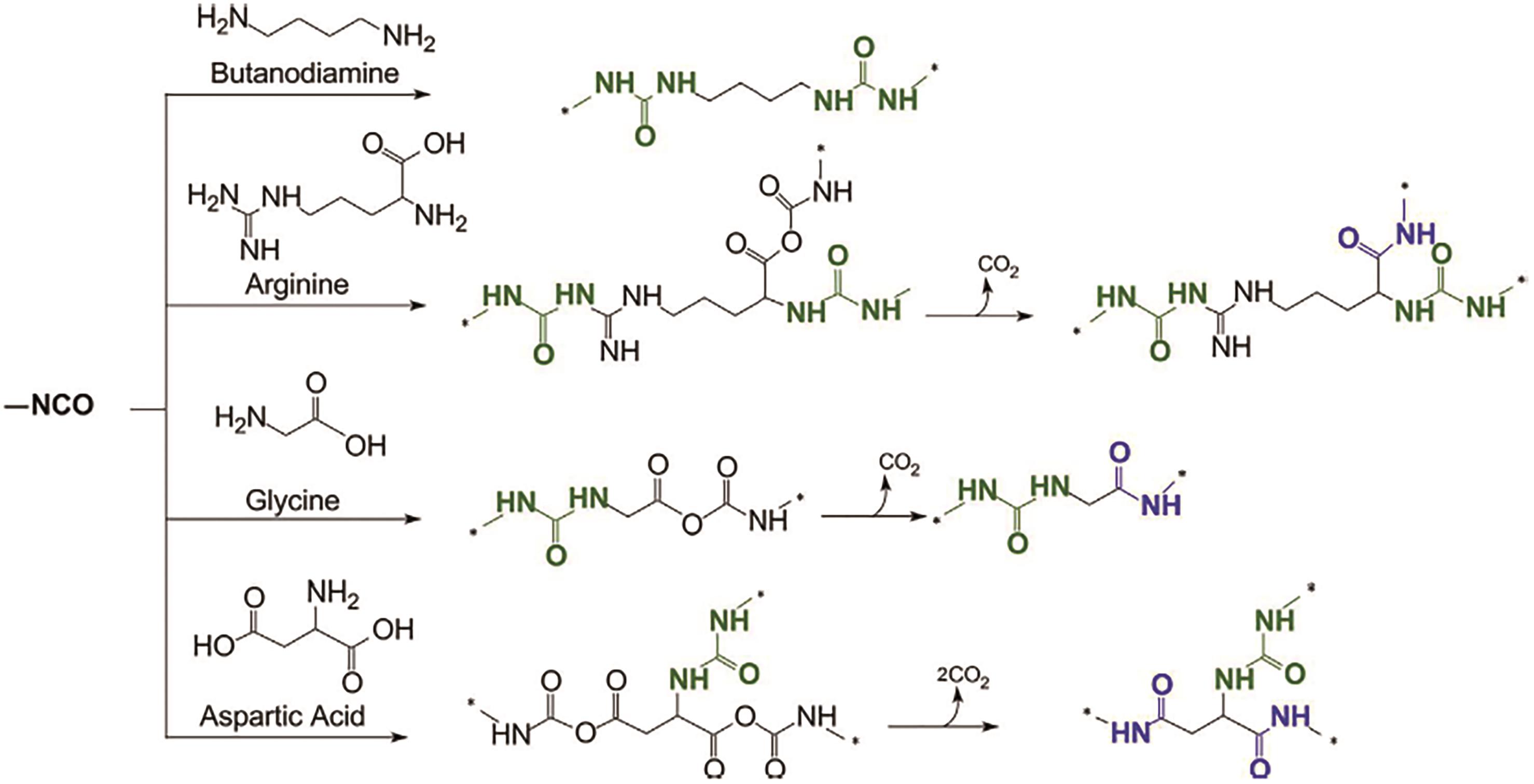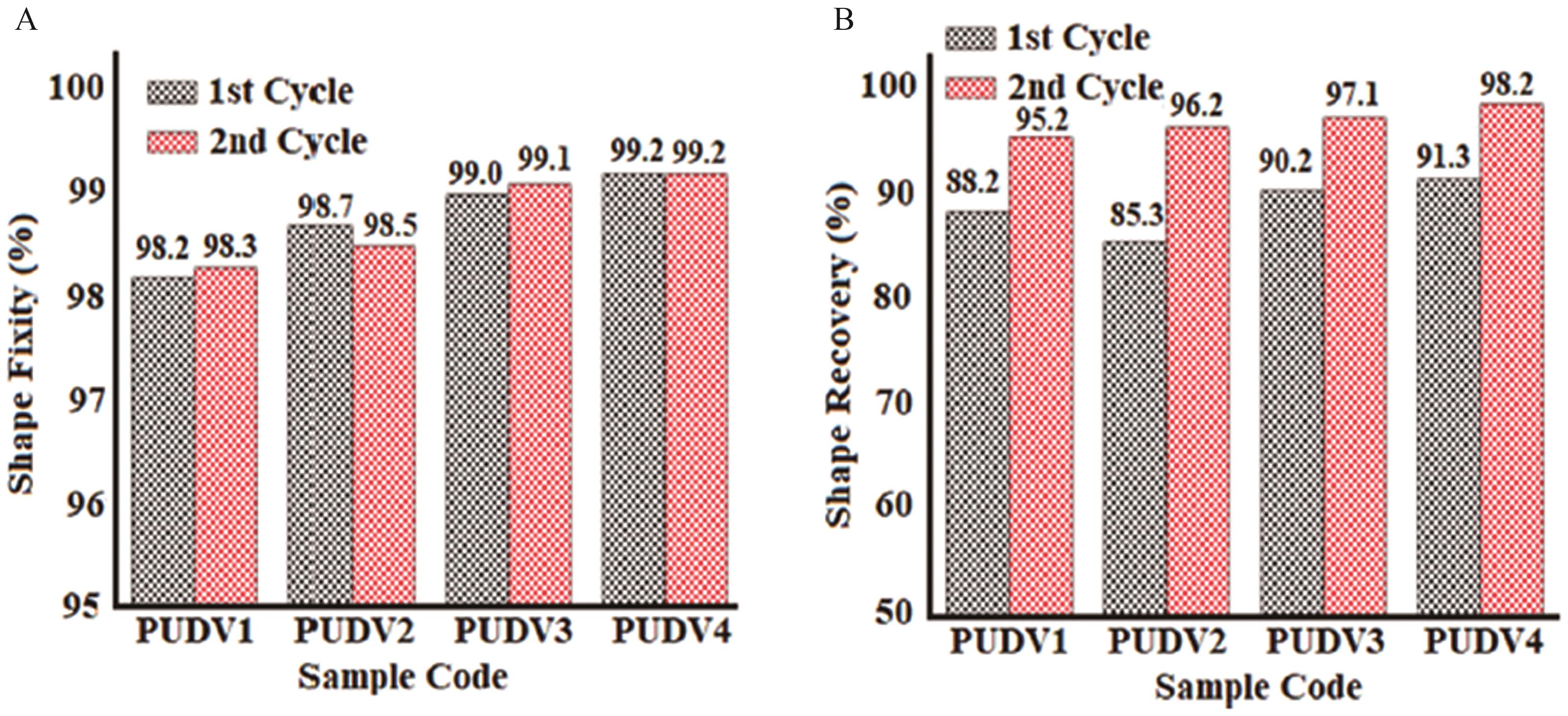
Chinese Journal of Applied Chemistry ›› 2025, Vol. 42 ›› Issue (1): 42-57.DOI: 10.19894/j.issn.1000-0518.240294
• Review • Previous Articles Next Articles
Research Progress on Preparation and Properties of Bio-Based Polyurethanes from Amino Acid and Its Derivatives
Guo-Hong TANG1,2, Zhen ZHAO3, Jia-Hui ZHONG1,2, Xiao-Ling XU1,2, Ying-Lu SUN1, De-Kun SHENG1, Yu-Ming YANG1,2( )
)
- 1.CAS Key Laboratory of High-Performance Synthetic Rubber and Its Composite Material,Changchun Institute of Applied Chemistry,Chinese Academy of Science,Changchun 130022,China
2.University of Science and Technology of China,Hefei 230026,China
3.Military Representative Office of the Air Force Armament Department in Changchun,Changchun 130000,China
-
Received:2024-09-06Accepted:2024-11-27Published:2025-01-01Online:2025-01-24 -
Contact:Yu-Ming YANG -
About author:ymyang@ciac.ac.cn
-
Supported by:the National Natural Science Foundation of China(22175171);the Natural Science Foundation of Jilin Province of China(SKL202302036)
CLC Number:
Cite this article
Guo-Hong TANG, Zhen ZHAO, Jia-Hui ZHONG, Xiao-Ling XU, Ying-Lu SUN, De-Kun SHENG, Yu-Ming YANG. Research Progress on Preparation and Properties of Bio-Based Polyurethanes from Amino Acid and Its Derivatives[J]. Chinese Journal of Applied Chemistry, 2025, 42(1): 42-57.
share this article
Add to citation manager EndNote|Ris|BibTeX
URL: http://yyhx.ciac.jl.cn/EN/10.19894/j.issn.1000-0518.240294
| Sample | Tg/℃ | Tensile strength/MPa | Elongation at break/% | Toughness/(MJ·m-3) | Young′s modulus/MPa |
|---|---|---|---|---|---|
| LBWPU-32% | -14.7 | 4.80±2.1 | 1 033±25 | 34.3±3.4 | 10.3±2.3 |
| LBWPU-38% | -13.8 | 11.3±3.5 | 1 015±16 | 61.0±2.7 | 19.7±3.1 |
| LBWPU-44% | -13.0 | 13.7±1.3 | 973±12 | 66.8±2.6 | 25.4±3.9 |
| LBWPU-48% | -12.1 | 21.5±2.9 | 802±31 | 82.5±4.9 | 51.2±2.9 |
| CBWPU-0.5% | -11.9 | 30.1±3.7 | 702±57 | 111±2.1 | 61.5±2.4 |
| CBWPU-1% | -11.0 | 41.5±1.7 | 663±35 | 131±1.0 | 87.6±3.7 |
| CBWPU-2% | -10.3 | 38.9±2.3 | 619±27 | 123±1.2 | 108±4.9 |
Table 1 Mechanical properties and Tg of BWPU[40]
| Sample | Tg/℃ | Tensile strength/MPa | Elongation at break/% | Toughness/(MJ·m-3) | Young′s modulus/MPa |
|---|---|---|---|---|---|
| LBWPU-32% | -14.7 | 4.80±2.1 | 1 033±25 | 34.3±3.4 | 10.3±2.3 |
| LBWPU-38% | -13.8 | 11.3±3.5 | 1 015±16 | 61.0±2.7 | 19.7±3.1 |
| LBWPU-44% | -13.0 | 13.7±1.3 | 973±12 | 66.8±2.6 | 25.4±3.9 |
| LBWPU-48% | -12.1 | 21.5±2.9 | 802±31 | 82.5±4.9 | 51.2±2.9 |
| CBWPU-0.5% | -11.9 | 30.1±3.7 | 702±57 | 111±2.1 | 61.5±2.4 |
| CBWPU-1% | -11.0 | 41.5±1.7 | 663±35 | 131±1.0 | 87.6±3.7 |
| CBWPU-2% | -10.3 | 38.9±2.3 | 619±27 | 123±1.2 | 108±4.9 |
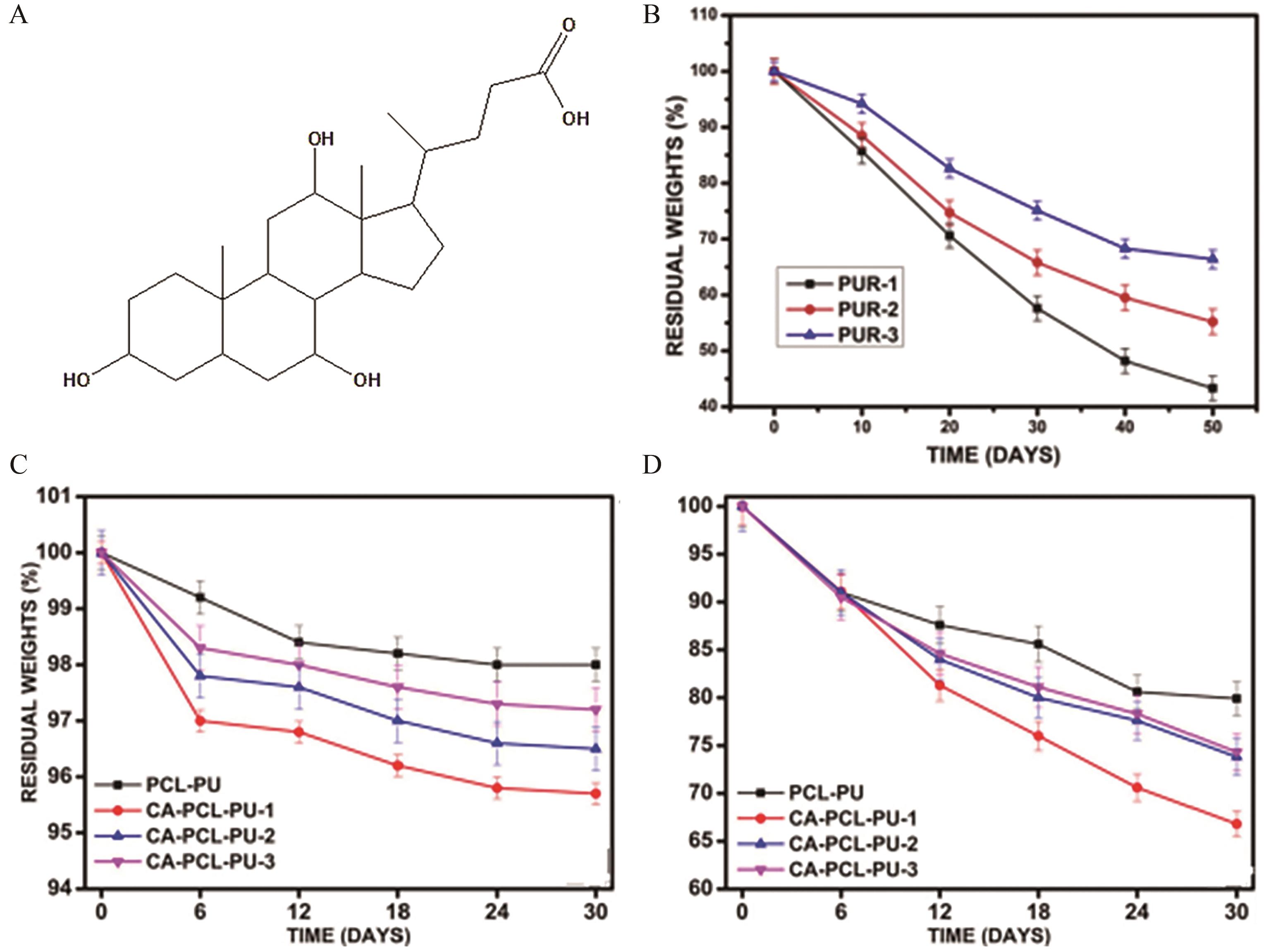
Fig.6 (A) Structure of cholic acid[41]; (B) The percentage of residual mass of polyurethanes (PURs) during the course of enzymatic degradation in the presence of porcine pancreatic lipase[42]; (C) Hydrolytic degradation behaviors of PCL-PU and CA-PCL-PU[43]; (D) Enzymatic degradation of PCL-PU and CA-PCL-PUs[43]
| Sample | Tm/℃ | Tensile strength/MPa | Elongation at break/% | Young′s modulus/MPa |
|---|---|---|---|---|
| PCL-PU | 65 | 18.68 | 11.66 | 171.61 |
| CA-PCL-PU-1 | 53 | 9.37 | 243.29 | 121.48 |
| CA-PCL-PU-2 | 50 | 10.85 | 313.50 | 138.67 |
| CA-PCL-PU-3 | 45 | 11.57 | 327.26 | 157.71 |
Table 2 Melt temperature and mechanical properties of the materials[43]
| Sample | Tm/℃ | Tensile strength/MPa | Elongation at break/% | Young′s modulus/MPa |
|---|---|---|---|---|
| PCL-PU | 65 | 18.68 | 11.66 | 171.61 |
| CA-PCL-PU-1 | 53 | 9.37 | 243.29 | 121.48 |
| CA-PCL-PU-2 | 50 | 10.85 | 313.50 | 138.67 |
| CA-PCL-PU-3 | 45 | 11.57 | 327.26 | 157.71 |
| Sample | Molecular mass | Tg/℃ | Mechanical properties | ||||
|---|---|---|---|---|---|---|---|
| 10-4Mn | 10-4Mw | PDI | Tensile strength/MPa | Elongation at break/% | Young′s modulus/MPa | ||
| PU-BDA-530 | 30.45 | 65.17 | 2.14 | 3 | 2.4±0.1 | 327±28 | 1.8±0.5 |
| PU-R-530 | 7.22 | 16.33 | 2.26 | 3 | 1.6±0.5 | 667±84 | 0.6±0.2 |
| PU-G-530 | 12.16 | 16.57 | 1.36 | 5 | 2.1±0.5 | 571±73 | 0.8±0.2 |
| PU-D-530 | 3.06 | 15.00 | 4.90 | 5 | 0.9±0.1 | 116±8 | 0.9±0.1 |
Table 3 Relative Molecular mass, Tg and mechanical properties of PU[52]
| Sample | Molecular mass | Tg/℃ | Mechanical properties | ||||
|---|---|---|---|---|---|---|---|
| 10-4Mn | 10-4Mw | PDI | Tensile strength/MPa | Elongation at break/% | Young′s modulus/MPa | ||
| PU-BDA-530 | 30.45 | 65.17 | 2.14 | 3 | 2.4±0.1 | 327±28 | 1.8±0.5 |
| PU-R-530 | 7.22 | 16.33 | 2.26 | 3 | 1.6±0.5 | 667±84 | 0.6±0.2 |
| PU-G-530 | 12.16 | 16.57 | 1.36 | 5 | 2.1±0.5 | 571±73 | 0.8±0.2 |
| PU-D-530 | 3.06 | 15.00 | 4.90 | 5 | 0.9±0.1 | 116±8 | 0.9±0.1 |
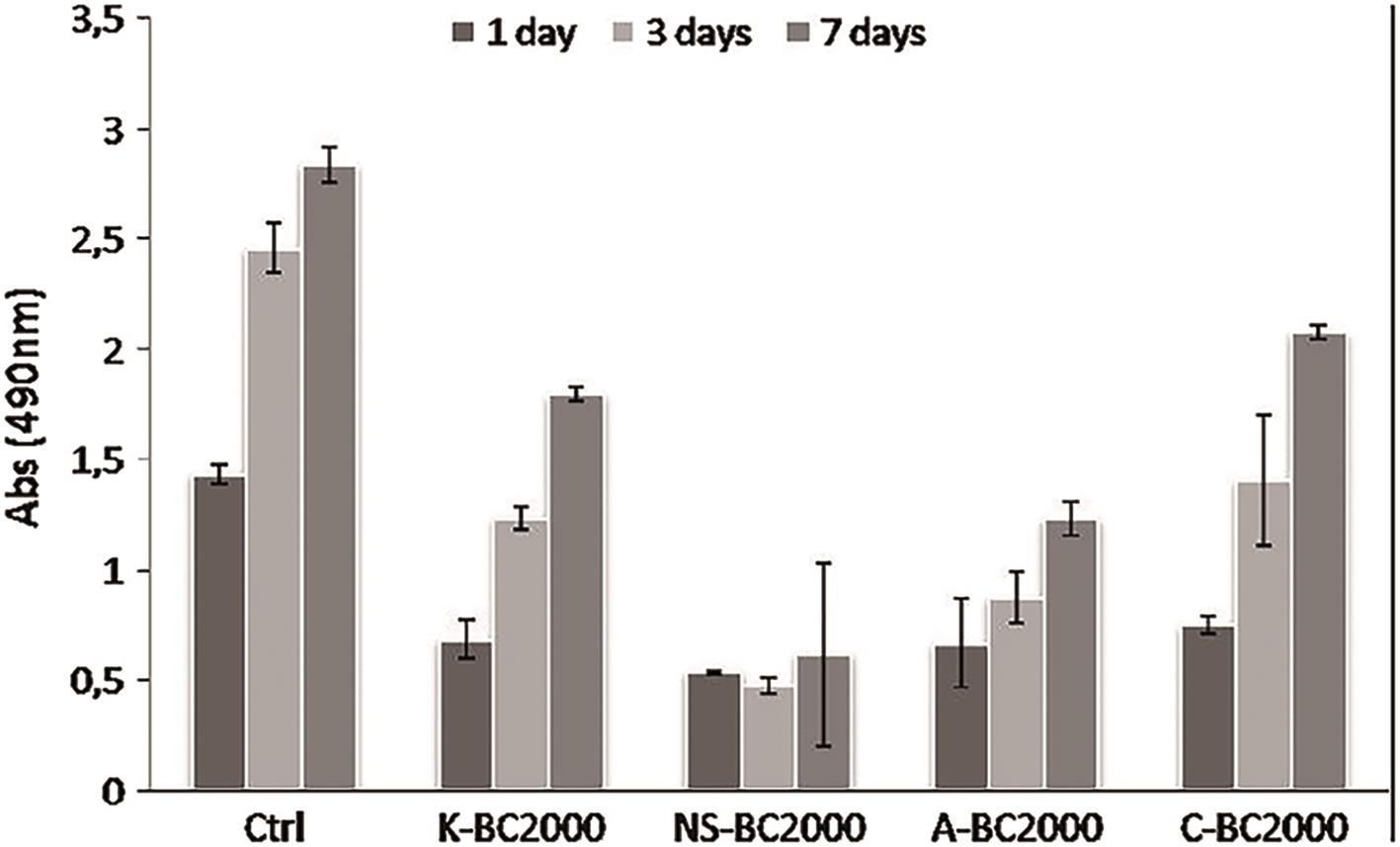
Fig.8 Skeletal myoblast growth on polystyrene cell culture plates (positive control) and the PURs. Optical absorbance at 490 nm is directly proportional to the amount of viable cells[56]
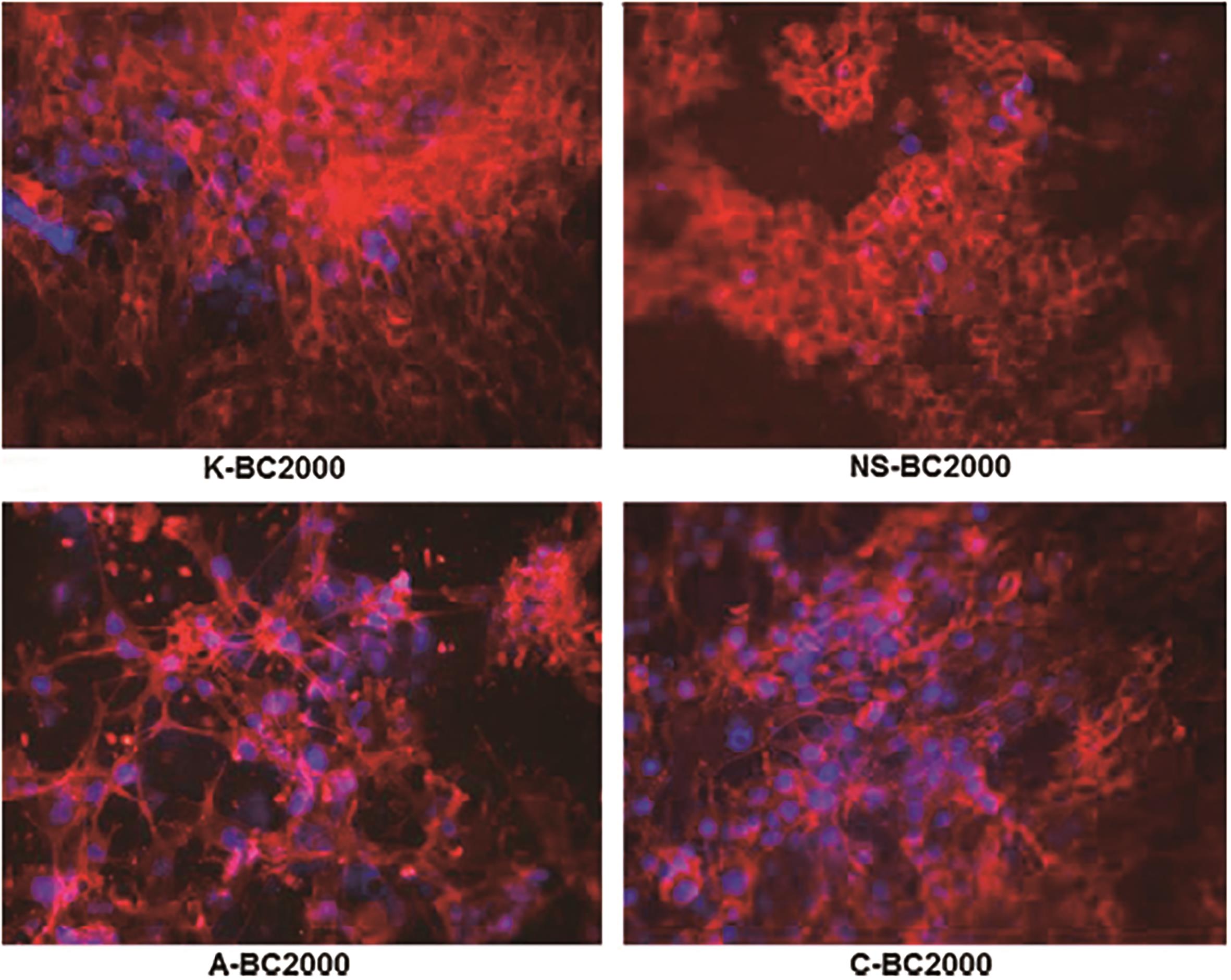
Fig.9 Actin cytoskeleton of myoblasts cultured for 7 days on the synthesised polyurethanes. Samples were stained with phalloidin-TRITC conjugated which specifically binds actin filaments and DAPI, a blue fluorescent dye specific for DNA[56]
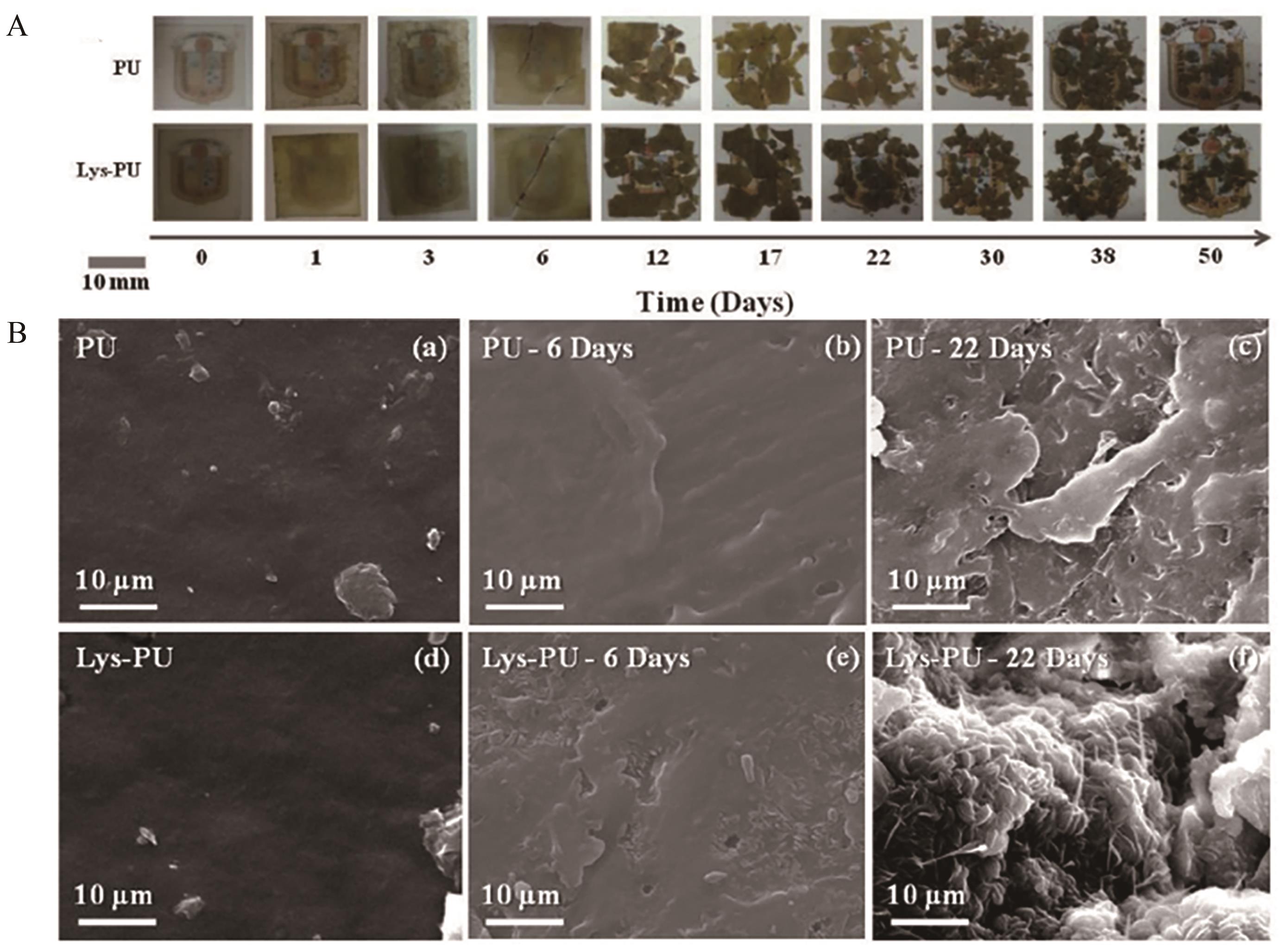
Fig.10 (A) Visual appearance of PU film samples after different days of degradation under composting conditions; (B) SEM observations of PU and lys-PU recovered films at different degradation time under composting conditions[57]
| 1 | CALVO-CORREAS T, MARTIN M D, RETEGI A, et al. Synthesis and characterization of polyurethanes with high renewable carbon content and tailored properties[J]. ACS Sustainable Chem Eng, 2016, 4(10): 5684-5692. |
| 2 | AKINDOYO J O, BEG M D H, GHAZALI S, et al. Polyurethane types, synthesis and applications-a review[J]. RSC Adv, 2016, 6(115): 114453-114482. |
| 3 | BAYER O. The diisocyanate polyaddition process (polyurethane)[J]. Angew Chem, 1947, 59(9): 257-272. |
| 4 | SKLENICKOVÁ K, ABBRENT S, HALECKY M, et al. Biodegradability and ecotoxicity of polyurethane foams: a review[J]. Crit Rev Environ Sci Technol, 2022, 52(2): 157-202. |
| 5 | 范鑫, 王欢, 黄峻榕. 生物基聚氨酯泡沫研究进展及其在食品包装中的应用[J]. 食品研究与开发, 2023, 44(24): 156-162. |
| FAN X, WANG H, HUANG J R. Research progress in bio-based polyurethane foam and its application in food packaging[J]. Food Res Dev, 2023, 44(24): 156-162. | |
| 6 | HU J, MO R, SHENG X, et al. A self-healing polyurethane elastomer with excellent mechanical properties based on phase-locked dynamic imine bonds[J]. Polym Chem, 2020, 11(14): 2585-2594. |
| 7 | 韦代东, 李惠枝, 曾娟娟, 等. 生物基聚氨酯抗涂鸦自清洁涂料的制备及性能[J]. 中国塑料, 2023, 37(2): 15-21. |
| WEI D D, LI H Z, ZENG J J, et al. Preparation and performance of biobased polyurethane anti-graffiti and self-cleaning coating[J]. China Plast, 2023, 37(2): 15-21. | |
| 8 | 周永红, 潘政, 张猛. 生物基聚氨酯材料的研究进展[J]. 生物质化学工程, 2023, 57(1): 1-12. |
| ZHOU Y H, PAN Z, ZHANG M. Recent progress in synthesis and application of bio-based polyurethanes[J]. Biomass Chem Eng, 2023, 57(1): 1-12. | |
| 9 | YU N, AN Z, ZHANG J, et al. Recent advances in tailored fabrication and properties of biobased self-healing polyurethane[J]. Biomacromolecules, 2023, 24(11): 4605-4621. |
| 10 | DE SOUZA F M, KAHOL P K, GUPTA R K. Polyols from sustainable resources[M]//GUPTA R K, KAHOL P K. Washington, DC: American Chemical Society, 2021: 25-49. |
| 11 | PARASKAR P M, PRABHUDESAI M S, HATKAR V M, et al. Vegetable oil based polyurethane coatings-a sustainable approach: a review[J]. Prog Org Coat, 2021, 156: 106267. |
| 12 | KUGLER S, OSSOWICZ P, MALARCZYK-MATUSIAK K, et al. Advances in rosin-based chemicals: the latest recipes, applications and future trends[J]. Molecules, 2019, 24(9): 1651. |
| 13 | MAISONNEUVE L, CHOLLET G, GRAU E, et al. Vegetable oils: a source of polyols for polyurethane materials[J]. OCL: Oilseeds Fats, Crops Lipids, 2016, 23(5): D508. |
| 14 | ZHU Y, GAO F, ZHONG J, et al. Renewable castor oil and DL-limonene derived fully bio-based vinylogous urethane vitrimers[J]. Eur Polym J, 2020, 135: 109865. |
| 15 | 赵梅, 刘馨远, 陈洋, 等. 基于非天然氨基酸的蛋白质合成研究进展[J]. 食品与发酵工业, 2024, 50(12): 336-342. |
| ZHAO M, LIU X Y, CHEN Y, et al. Research progress on protein synthesis based on unnatural amino acids[J]. Food Ferment Ind, 2024, 50(12): 336-342. | |
| 16 | 刘慧, 刘骁, 曹远桥, 等. 氨基酸基聚合物在抗菌领域的研究进展[J]. 应用化学, 2021, 38(5): 559-571. |
| LIU H, LIU X, CAO Y Q, et al. Research progress on amino acid-based antimicrobial polymers[J]. Chin J Appl Chem, 2021, 38(5): 559-571. | |
| 17 | CHARLON M, HEINRICH B, MATTER Y, et al. Synthesis, structure and properties of fully biobased thermoplastic polyurethanes, obtained from a diisocyanate based on modified dimer fatty acids, and different renewable diols[J]. Eur Polym J, 2014, 61: 197-205. |
| 18 | BROCAS A, MANTZARIDIS C, TUNC D, et al. Polyether synthesis: from activated or metal-free anionic ring-opening polymerization of epoxides to functionalization[J]. Prog Polym Sci, 2013, 38(6): 845-873. |
| 19 | HUANG S, LIU G, ZHANG K, et al. Water-based polyurethane formulations for robust superhydrophobic fabrics[J]. Chem Eng J, 2019, 360: 445-451. |
| 20 | LU W, WANG X, CHENG R, et al. Biocompatible and bioreducible micelles fabricated from novel α-amino acid-based poly(disulfide urethane)s: design, synthesis and triggered doxorubicin release[J]. Polym Chem, 2015, 6(33): 6001-6010. |
| 21 | ZHOU L, LIANG D, HE X, et al. The degradation and biocompatibility of pH-sensitive biodegradable polyurethanes for intracellular multifunctional antitumor drug delivery[J]. Biomaterials, 2012, 33(9): 2734-2745. |
| 22 | XIE Z, LU C, CHEN X, et al. A facile approach to biodegradable poly(ε-caprolactone)-poly(ethylene glycol)-based polyurethanes containing pendant amino groups[J]. Eur Polym J, 2007, 43(5): 2080-2087. |
| 23 | COHN D, HOTOVELY-SALOMON A. Biodegradable multiblock PEO/PLA thermoplastic elastomers: molecular design and properties[J]. Polymer, 2005, 46(7): 2068-2075. |
| 24 | GAVHANE U A, JOSHI D C, JAYAKANNAN M. Size- and shape-controlled biodegradable polymer brushes based on L-amino acid for intracellular drug delivery and deep-tissue penetration[J]. Biomacromolecules, 2024, 25(6): 3756-3774. |
| 25 | DATTA J, KASPRZYK P. Thermoplastic polyurethanes derived from petrochemical or renewable resources: a comprehensive review[J]. Polym Eng Sci, 2018, 58(S1): E14-E35. |
| 26 | PARCHETA P, DATTA J. Environmental impact and industrial development of biorenewable resources for polyurethanes[J]. Crit Rev Environ Sci Technol, 2017, 47(20): 1986-2016. |
| 27 | JAVNI I, ZHANG W, PETROVIĆ Z S. Effect of different isocyanates on the properties of soy-based polyurethanes[J]. J Appl Polym Sci, 2003, 88(13): 2912-2916. |
| 28 | EWA G, PAULINA P, PAULINA K, et al. Polyisocyanates from sustainable resources[M]//GUPTA R K, KAHOL P K. Washington, DC: American Chemical Society, 2021: 51-73. |
| 29 | BŁAŻEK K, DATTA J. Renewable natural resources as green alternative substrates to obtain bio-based non-isocyanate polyurethanes-review[J]. Crit Rev Environ Sci Technol, 2019, 49(3): 173-211. |
| 30 | PRUEITT R L, LYNCH H N, ZU K, et al. Dermal exposure to toluene diisocyanate and respiratory cancer risk[J]. Environ Int, 2017, 109: 181-192. |
| 31 | LUNA L G, GREEN B J, ZHANG F, et al. Quantitation of 4,4′-methylene diphenyl diisocyanate human serum albumin adducts[J]. Toxicol Rep, 2014, 1: 743-751. |
| 32 | ÇAYLI G, KÜSEFOĞLU S. Biobased polyisocyanates from plant oil triglycerides: synthesis, polymerization, and characterization[J]. J Appl Polym Sci, 2008, 109(5): 2948-2955. |
| 33 | GHOSH A K, SARKAR A, BRINDISI M. The Curtius rearrangement: mechanistic insight and recent applications in natural product syntheses[J]. Org Biomol Chem, 2018, 16(12): 2006-2027. |
| 34 | WALLIS E S, LANE J F. The Hofmann reaction[M]//Hoboken, New Jersey: John Wiley and Sons, Inc, 2011: 267-306. |
| 35 | ABDELHAFEZ E M N, ALY O M, ABUO-RAHMA G E A A, et al. Lossen rearrangements under Heck reaction conditions[J]. Adv Synth Catal, 2014, 356(16): 3456-3464. |
| 36 | ROKICKI G, PARZUCHOWSKI P G, MAZUREK M. Non-isocyanate polyurethanes: synthesis, properties, and applications[J]. Polym Adv Technol, 2015, 26(7): 707-761. |
| 37 | KHATOON H, IQBAL S, IRFAN M, et al. A review on the production, properties and applications of non-isocyanate polyurethane: a greener perspective[J]. Prog Org Coat, 2021, 154: 10612. |
| 38 | LI Y, NOORDOVER B A J, VAN BENTHEM R A T M, et al. Reactivity and regio-selectivity of renewable building blocks for the synthesis of water-dispersible polyurethane prepolymers[J]. ACS Sustainable Chem Eng, 2014, 2(4): 788-797. |
| 39 | KARBASI A, DARVISHI R, ENAYATI GERDROODBAR A, et al. Kinetic analysis of the reaction between tannic acid (TA) and L-lysine diisocyanate (LDI) systems[J]. Int J Polym Sci, 2023, 2023: 1-11. |
| 40 | XUE M, RAO X, LI W, et al. Waterborne polyurethane synthesized for leather with excellent wear and hydrolysis resistance enabled by bio-based poly(trimethylene carbonate) and L-lysine diisocyanate[J]. Prog Org Coat, 2024, 193: 108553. |
| 41 | LI C, LAVIGUEUR C, ZHU X X. Aggregation and thermoresponsive properties of new star block copolymers with a cholic acid core[J]. Langmuir, 2011, 27(17): 11174-11179. |
| 42 | ACIK G, KARABULUT H R F, ALTINKOK C, et al. Synthesis and characterization of biodegradable polyurethanes made from cholic acid and L-lysine diisocyanate ethyl ester[J]. Polym Degrad Stab, 2019, 165: 43-48. |
| 43 | ACIK B, ACIK G, ERDEMI H. Synthesis and characterization of bile acid, poly(ε-caprolactone) and L-lysine diisocyanate ethyl ester based polyurethanes and investigation of their biodegradability properties[J]. Eur Polym J, 2021, 146: 110247. |
| 44 | CHATTOPADHYAY D K, WEBSTER D C. Thermal stability and flame retardancy of polyurethanes[J]. Prog Polym Sci, 2009, 34(10): 1068-1133. |
| 45 | LI W, LI H, WU C, et al. An effective synthesis of bio-based pentamethylene diisocyanate in a jet loop reactor[J]. Chem Eng J, 2021, 425: 131527. |
| 46 | HE F, TANG Y, LU Z, et al. An effective purification of double-effect distillation for bio-based pentamethylene diisocyanate[J]. RSC Adv, 2023, 13(45): 31518-31527. |
| 47 | JASIŪNAS L, PECK G, BRIDŽIUVIENĖ D, et al. Mechanical, thermal properties and stability of high renewable content liquefied residual biomass derived bio-polyurethane wood adhesives[J]. Int J Adhes Adhes, 2020, 101: 102618. |
| 48 | SHEIKHY H, SHAHIDZADEH M, RAMEZANZADEH B, et al. Studying the effects of chain extenders chemical structures on the adhesion and mechanical properties of a polyurethane adhesive[J]. J Ind Eng Chem, 2013, 19(6): 1949-1955. |
| 49 | ONIKI Y, SUZUKI K, HIGAKI Y, et al. Molecular design of environmentally benign segmented polyurethane(urea)s: effect of the hard segment component on the molecular aggregation states and biodegradation behavior[J]. Polym Chem, 2013, 4(13): 3735-3743. |
| 50 | ZHENG N, FANG Z, ZOU W, et al. Thermoset shape-memory polyurethane with intrinsic plasticity enabled by transcarbamoylation[J]. Angew Chem, 2016, 128(38): 11593-11597. |
| 51 | GUELCHER S A, GALLAGHER K M, DIDIER J E, et al. Synthesis of biocompatible segmented polyurethanes from aliphatic diisocyanates and diurea diol chain extenders[J]. Acta Biomater, 2005, 1(4): 471-484. |
| 52 | CHAN-CHAN L H, GONZÁLEZ-GARCÍA G, VARGAS-CORONADO R F, et al. Characterization of model compounds and poly(amide-urea) urethanes based on amino acids by FTIR, NMR and other analytical techniques[J]. Eur Polym J, 2017, 92: 27-39. |
| 53 | LU Q W, HOYE T R, MACOSKO C W. Reactivity of common functional groups with urethanes: models for reactive compatibilization of thermoplastic polyurethane blends[J]. J Polym Sci, Part A: Polym Chem, 2002, 40(14): 2310-2328. |
| 54 | VENEGAS-CERVERA G A, OLIVA A I, AVILA-ORTEGA A, et al. Biocompatibility studies of polyurethane electrospun membranes based on arginine as chain extender[J]. J Mater Sci: Mater Med, 2021, 32(9): 104. |
| 55 | GUPTA S S, MISHRA V, MUKHERJEE M D, et al. Amino acid derived biopolymers: recent advances and biomedical applications[J]. Int J Biol Macromol, 2021, 188: 542-567. |
| 56 | SARTORI S, BOFFITO M, SERAFINI P, et al. Synthesis and structure-property relationship of polyester-urethanes and their evaluation for the regeneration of contractile tissues[J]. React Funct Polym, 2013, 73(10): 1366-1376. |
| 57 | ARRIETA M P, RIVERA K, SALGADO C, et al. Degradation under composting conditions of lysine-modified polyurethane based on PCL obtained by lipase biocatalysis[J]. Polym Degrad Stab, 2018, 152: 139-146. |
| 58 | CALVO-CORREAS T, SHIROLE A, CRIPPA F, et al. Biocompatible thermo- and magneto-responsive shape-memory polyurethane bionanocomposites[J]. Mater Sci Eng, C, 2019, 97: 658-668. |
| 59 | GNANASEKAR P, CHEN H, LUO Q, et al. Mechanically robust, degradable, catalyst-free fully bio-based shape memory polyurethane: influence of a novel vanillin-alaninol chain extender[J]. ACS Sustainable Chem Eng, 2022, 10(16): 5203-5211. |
| 60 | GRZELAK A W, BOINARD P, LIGGAT J J. The influence of diol chain extender on morphology and properties of thermally-triggered UV-stable self-healing polyurethane coatings[J]. Prog Org Coat, 2018, 122: 1-9. |
| 61 | YING W B, YU Z, KIM D H, et al. Waterproof, highly tough, and fast self-healing polyurethane for durable electronic skin[J]. ACS Appl Mater Interfaces, 2020, 12(9): 11072-11083. |
| 62 | XU B, YIN Q, HAN F, et al. A Bio-based healable/renewable polyurethane elastomer derived from L-tyrosine/vanillin/dimer acid[J]. Chem Eng Sci, 2022, 258: 117736. |
| [1] | Liang XU, Jian-Peng LIU, Jian QING. Research Progress in Design, Synthesis and Properties of Organic Octupolar Two-Photon Excited Fluorescence Materials [J]. Chinese Journal of Applied Chemistry, 2025, 42(1): 29-41. |
| [2] | Yuan-Jie LI, Bing-Bing FAN, Jun-Li ZHANG, Yan-Mei ZHOU. Research Progress in the Application of Amino Acid Ionic Liquids to Energy Storage and Biomass Resource Utilization [J]. Chinese Journal of Applied Chemistry, 2024, 41(3): 391-404. |
| [3] | Yun HONG, Xiao-Ye MA, Jing-Wei HOU, Ding-Xiao JIANG, Chuan-Qing KANG. Synthesis and Properties of Polyurethane Containing Polypeptide from Silk Fibroin [J]. Chinese Journal of Applied Chemistry, 2024, 41(10): 1425-1435. |
| [4] | Jun-Jie SHI, Zhe-Hang SHI, Hong-Zhou LI. Preparation of Magnesium Aluminum-Type Hydrotalcite Compounds Intercalated with Phosphorus Flame Retardants and Their Flame Retardant Application in Thermoplastic Polyurethane [J]. Chinese Journal of Applied Chemistry, 2023, 40(9): 1288-1301. |
| [5] | Yu-Zhu CHEN, Si-Si LIU, Meng-Meng ZHANG, Xiang-De LIN, Dong-Dong ZENG. Polyurethane Dressing Based on Antibacterial Chitosan/Carboxymethyl Cellulose Composite Drug Coating [J]. Chinese Journal of Applied Chemistry, 2023, 40(2): 252-260. |
| [6] | Bi-Ru SHI, Hao-Hao WU, Hao-Pu XIE, Xin-Xin TIAN, Ying-Lu SUN, Xiang-Dong LIU, Yu-Ming YANG. Preparation and Properties of Self-healing Polyurethane Adhesives with Diels-Alder Bonds [J]. Chinese Journal of Applied Chemistry, 2023, 40(2): 277-287. |
| [7] | Dan ZHANG, Fang LIU, Xue YANG, Dong-Hua XU, Tong-Fei SHI. Relationship Between Hardness and Impact Properties of Thermoplastic Polyurethane Blends [J]. Chinese Journal of Applied Chemistry, 2022, 39(8): 1216-1223. |
| [8] | WU Qiu-Ping, CAI Kun-Ting, WANG Yuan-Kang, SUN Kai, YANG Jin-Bo, HAN Song-Bai, LIU Yun-Tao. Microwave Absorption Properties of Co/C and Microwave-Heat Conversion Properties of Co/C-Polyurethane Phase Change Composites [J]. Chinese Journal of Applied Chemistry, 2021, 38(12): 0-0. |
| [9] | WU Qiu-Ping, CAI Kun-Ting, WANG Yuan-Kang, SUN Kai, YANG Jin-Bo, HAN Song-Bai, LIU Yun-Tao. Microwave Absorption Properties of Co/C and Microwave-Heat Conversion Properties of Co/C-Polyurethane Phase Change Composites [J]. Chinese Journal of Applied Chemistry, 2021, 38(12): 1588-1598. |
| [10] | PAN Ge, LIU Fang, FU Zhilei, LI Shuangshuang, XU Donghua, XU Zhaohua, SHI Tongfei, WANG Xiaowei, MA Rui. Effect of Mass Fraction of Color Paste in Waterborne Polyurethane Coatings on Low Temperature Blasting Properties of Polyvinyl Chloride Skin [J]. Chinese Journal of Applied Chemistry, 2020, 37(2): 182-189. |
| [11] | GUO Xiaoyan, CHENG Xiaoqi, ZHANG Liangliang, HUANG Yiping, XU Gewen, BAO Junjie. Preparation and Properties of Sulfonic Waterborne Polyurethane Hydrogels with Sodium N,N-Bis (2-hydroxyethyl)-2-aminoethane Sulfonate as Chain Extender [J]. Chinese Journal of Applied Chemistry, 2019, 36(6): 631-640. |
| [12] | CHEN Guangmei,WANG Zhikun,WU Lixia,HUANG Yiping. Preparation and Properties of Polyurethane Modified by Acrylate/Nano-SiO2 Composites [J]. Chinese Journal of Applied Chemistry, 2019, 36(5): 532-538. |
| [13] | TIAN Yumeng, LI Xuemin, LI Xiaoxiao, HUAN Yan, YE Feng, YANG Xiaoniu. Effect of Molecular Cross-linking Degrees on the Morphology and Tribological Properties of 1,4-Phenylene Diisocyanate-Based Polyurethane Elastomers [J]. Chinese Journal of Applied Chemistry, 2018, 35(9): 1148-1154. |
| [14] | REN Xiaoni, HONG Ling, GAO Chenqi, TIAN Caiyun. Preparation of Self-leveling Polyurethane and Sound Insulation Performance of Damped Decks [J]. Chinese Journal of Applied Chemistry, 2018, 35(10): 1215-1221. |
| [15] | YIN Zhigang, LIU Zhenzhen, QIAN Hengyu, WANG Zaifeng, ZHAO Xile, PENG Lifang, YUAN Qi. Synthesis of a Polymerizable Dye Monomer and Its Application in Dyeing Polyurethane Leather [J]. Chinese Journal of Applied Chemistry, 2017, 34(6): 649-655. |
| Viewed | ||||||
|
Full text |
|
|||||
|
Abstract |
|
|||||
